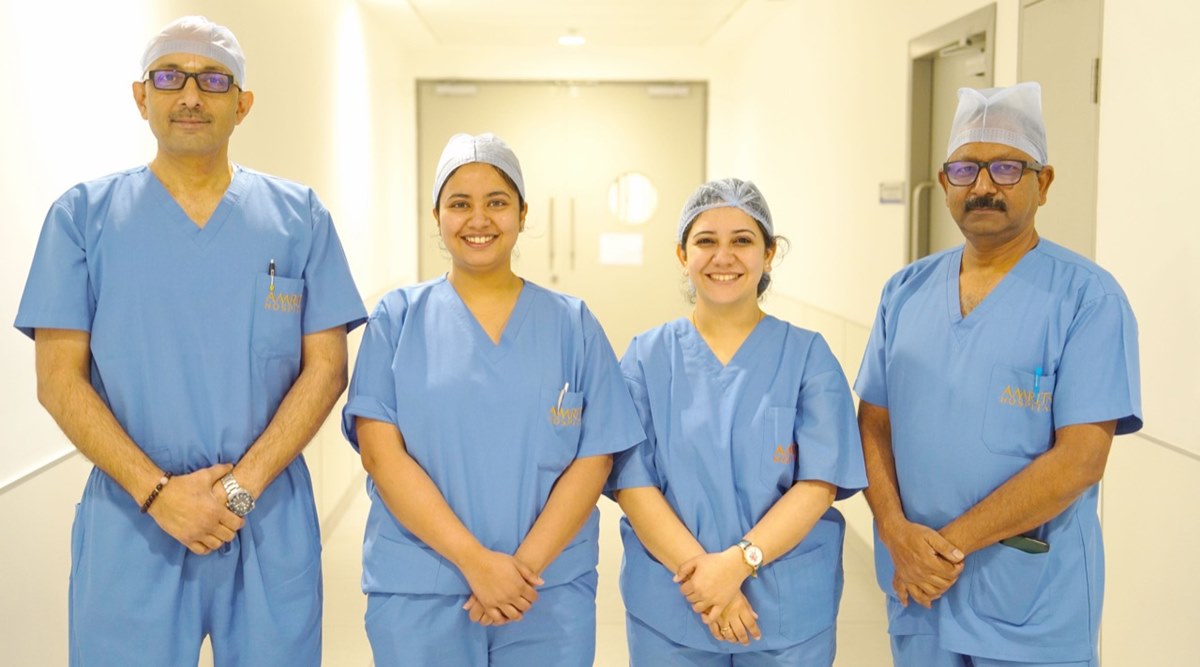
A 23-year-old woman from the Middle East never got to enjoy motherhood as she could never carry her baby to full term. Having gone through three abortions, she didn’t have the heart for the fourth one. But not only did she lose her baby, she also struggled with her giant breast size, a rare condition induced by her pregnancy. She was suffering from bilateral gestational gigantomastia, when some women develop extremely large breasts due to excessive and disproportionate breast tissue growth during their pregnancy.
Her breasts had grown extremely large in size, weighing as much as 11 kg, the tissue mass almost reaching down to her knees. She could barely stand for more than five minutes and hardly venture out of her house or do her chores. After suffering from the condition for seven months, she finally got the big burden off her chest when she was successfully operated upon by a team of specialists at Amrita Hospital, Faridabad, in a surgery that lasted ten hours. Said she, “I am happy to look normal, like I used to earlier. And reclaim my life from where I left off.”
WHY WAS THIS CASE RARE?
She did try several hospitals in her own country and elsewhere in India but was told that her breast needed to be amputated and would need reconstruction with implants at a later date. She was also told her surgery could be high-risk and life-threatening. Finally, she found hope at Faridabad’s Amrita Hospital. Said Dr Mohit Sharma, Head, Plastic and Reconstructive Surgery, “The patient came to us with extremely large breasts. She had a history of three abortions in previous years. She suffered from bilateral gestational gigantomastia during her third pregnancy, which also ended in spontaneous abortion at 22 weeks of gestation. The woman started developing extreme breast enlargement during this period and came to us after suffering from the condition for many months. Surgery in this case was very challenging and required a multidisciplinary team approach to optimise outcomes.”
Subscriber Only Stories
For Dr Sharma, this was a career challenge as he did not see anything like this in his 25 years as surgeon. “We did a lot of research and could only find a few cases of this nature. Normally, most cases of overgrowth in gigantomastia have reported a tissue pileup up to the pelvis and abdomen, but not below the knees as in this case. Our patient was suffering from connective tissue disorder. In such a condition, the tissues become lax and spread out. There is a regular enlargement of breasts in pregnancy but in her case, her disorder meant that her breast had grown by over 20 times. She was originally very lean, but this huge mass affected her mobility. She could hardly move around or even sit in one position comfortably, and felt giddy. Thankfully, as she was young, her cardiac reserve was not affected. Her veins and vessels had enlarged too. So when you try to make surgical cuts, there is a possibility of heavy bleeding. That’s why we decided to use a harmonic scalpel, which coagulates the blood during a procedure,” he says.
AN INNOVATIVE MODEL
The surgeons, led by Dr Sharma, decided to opt for a mastectomy and free nipple grafts where the nipples are completely removed from the breast and replaced as a skin graft. Other types of breast reduction surgeries would not have worked in this case, as maintaining the blood supply to nipple and areola would not have been possible. The doctors went ahead with mastectomy and took the nipple-and-areola complex as a separate, full-thickness graft on top of the reduced breast.
Sharing details of the surgery, Dr Sharma said, “We came up with an innovative plan in which we used the skin flaps of the large breasts as fillers to maintain the breast volume. So, the breast was amputated in a particular fashion, and the excess skin flap and fat were derived from the remaining tissue. The skin was removed from the outer and inner flaps, and then we folded the tissue flap to maintain the volume inside the breast envelope. After stopping the bleeding with a special harmonic scalpel, we closed the breast in a meticulous fashion after inserting some drains to take out the excess blood and secretions.”
He added, “We then placed a nipple-and-areola graft on a pre-marked site, secured it with a special glue, and covered it with a dressing to allow for full healing after grafting. This case was particularly complex as it was very difficult to stop bleeding and create a normal-looking breast. However, with our planning and a two-team approach, we could minimise the blood loss and achieve a result that was satisfactory to the patient.”
WALK BACK TO NORMALCY
Advertisement
The procedure and post-surgical recovery of the patient went well, and she can now walk and move freely without any restrictions. As a treatment modality, she may require additional correction later. “The only adverse effect is that she cannot breastfeed as we have removed her lactating ducts and her breast tissues. She has to wear a sports bra for the next six months and then she can be as normal as any other girl,” says Dr Sharma.
Dr Sharma was assisted by three other surgeons, including Senior Consultant, Dr Anil Murarka, Dr Vasundhra Jain and Dr Neha Suri.
"breast" - Google News
January 20, 2023 at 07:27PM
https://ift.tt/JLbBuga
Rare surgery helps 23-year-old Middle Eastern woman get rid of gigantic breasts - The Indian Express
"breast" - Google News
https://ift.tt/9WUwslm
https://ift.tt/FZC0wmX
Bagikan Berita Ini














0 Response to "Rare surgery helps 23-year-old Middle Eastern woman get rid of gigantic breasts - The Indian Express"
Post a Comment